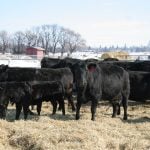While much of the world was watching the World Cup playing in his home country, Rafael Fuentes was in Western Canada transfixed with dirt.
To him, soil conservation is a much bigger deal.
“This is very, very important,” Fuentes, a soil conservation re-searcher in Brazil’s southern Parana state, said in an interview at the opening reception of the World Con-gress on Conservation Agriculture, held in Winnipeg June 22-25.
His attitude was shared across the spectrum of farmers, researchers, extension agronomists and government officials who attended the congress, which is held once every three years.
Read Also

VIDEO: Agritechnica Day 4: Robots and more robots, Nexat loves Canada and the trouble with tariffs
Agritechnica Day 4: Robots and more robots, Nexat loves Canada and the trouble with tariffs.
Conservation agriculture in myriad forms has long dominated thinking in North America, with the 1930s dustbowl spurring 80 years of development and the evolution of no-till farming in recent years coming close to total soil protection.
However, development is less widespread in many regions.
It’s an issue Kenya’s Saidi Mkomwa is attempting to address. He is trying to expand the reach of conservation agriculture to the many small-scale farmers who don’t have the machinery that makes no-till easy.
“For large-scale farmers, (no-till) is good business and good economics,” said Mkomwa.
“For smallholders, it’s slower than what we want.”
Joyce Mulila Mitti of the United Nations’ Food and Agriculture Organization in Accra, Ghana, said getting conservation agriculture practices adopted across Africa’s farming zones is essential.
“FAO considers it a priority,” said Mulila Mitti.
The congress brought together hundreds of experts and advocates for conservation agriculture and drew in famous speakers, such as soil conservation evangelist David Montgomery and philanthropist Howard Buffet.
Soil conservation is a lifelong dedication for some who attended, such as Jerry Lemunyon, a retired U.S. Department of Agriculture soil conservation extension expert.
“It was more than a job. It was a passion,” said Lemunyon, who worked for the USDA for 39 years. He still attends events like this to stay plugged in to current research and experience.
“We’re trying to keep up with the currents and this is worldwide, so there are a lot of synergies,” said Lemunyon.
Canada plays a prominent role in soil conservation research, development and experience, with Western Canada now dominated by no-till practices.
Glen Shaw, executive director of the Soil Conservation Council of Canada, said it’s nice for prairie farmers to see themselves at the leading edge of a worldwide agricultural development. Prairie no-till machinery is now used around the world.
“They can learn what has been successful in Canada,” Shaw said about the foreign visitors touring prairie farms during the congress.
However, having the foreign ex-perts come here also gives Canadian farmers and researchers access to valuable experiences beyond the neighbourhood.
“We hope we can learn from what they’ve learned,” said Shaw.















